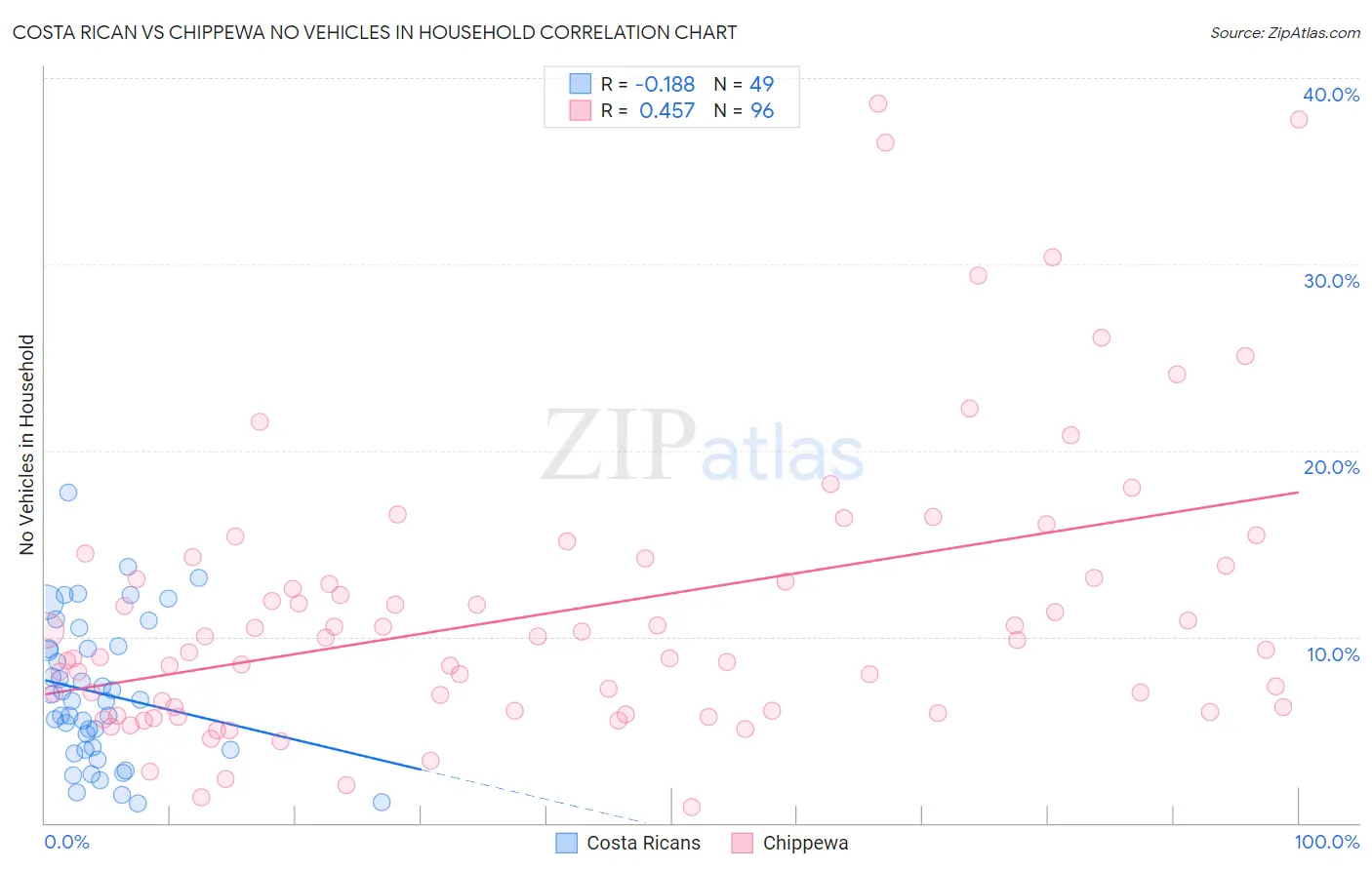Costa Rican vs Chippewa No Vehicles in Household
COMPARE
Costa Rican
Chippewa
No Vehicles in Household
No Vehicles in Household Comparison
Costa Ricans
Chippewa
9.5%
NO VEHICLES IN HOUSEHOLD
92.3/ 100
METRIC RATING
122nd/ 347
METRIC RANK
9.4%
NO VEHICLES IN HOUSEHOLD
93.8/ 100
METRIC RATING
117th/ 347
METRIC RANK
Costa Rican vs Chippewa No Vehicles in Household Correlation Chart
The statistical analysis conducted on geographies consisting of 253,314,745 people shows a poor negative correlation between the proportion of Costa Ricans and percentage of households with no vehicle available in the United States with a correlation coefficient (R) of -0.188 and weighted average of 9.5%. Similarly, the statistical analysis conducted on geographies consisting of 214,718,200 people shows a moderate positive correlation between the proportion of Chippewa and percentage of households with no vehicle available in the United States with a correlation coefficient (R) of 0.457 and weighted average of 9.4%, a difference of 0.87%.

No Vehicles in Household Correlation Summary
| Measurement | Costa Rican | Chippewa |
| Minimum | 1.0% | 0.88% |
| Maximum | 17.8% | 38.6% |
| Range | 16.7% | 37.7% |
| Mean | 7.0% | 11.3% |
| Median | 6.6% | 9.5% |
| Interquartile 25% (IQ1) | 3.9% | 6.0% |
| Interquartile 75% (IQ3) | 9.4% | 13.5% |
| Interquartile Range (IQR) | 5.5% | 7.5% |
| Standard Deviation (Sample) | 3.8% | 7.6% |
| Standard Deviation (Population) | 3.8% | 7.5% |
Demographics Similar to Costa Ricans and Chippewa by No Vehicles in Household
In terms of no vehicles in household, the demographic groups most similar to Costa Ricans are Puget Sound Salish (9.5%, a difference of 0.050%), Immigrants from Thailand (9.5%, a difference of 0.15%), Fijian (9.5%, a difference of 0.21%), Greek (9.5%, a difference of 0.32%), and Blackfeet (9.6%, a difference of 0.46%). Similarly, the demographic groups most similar to Chippewa are Japanese (9.4%, a difference of 0.17%), Navajo (9.4%, a difference of 0.24%), Serbian (9.4%, a difference of 0.30%), Greek (9.5%, a difference of 0.55%), and Fijian (9.5%, a difference of 0.66%).
| Demographics | Rating | Rank | No Vehicles in Household |
| Maltese | 97.6 /100 | #109 | Exceptional 9.1% |
| Delaware | 97.2 /100 | #110 | Exceptional 9.2% |
| Immigrants | Kuwait | 95.1 /100 | #111 | Exceptional 9.4% |
| Armenians | 95.0 /100 | #112 | Exceptional 9.4% |
| Immigrants | Netherlands | 94.8 /100 | #113 | Exceptional 9.4% |
| Serbians | 94.3 /100 | #114 | Exceptional 9.4% |
| Navajo | 94.2 /100 | #115 | Exceptional 9.4% |
| Japanese | 94.1 /100 | #116 | Exceptional 9.4% |
| Chippewa | 93.8 /100 | #117 | Exceptional 9.4% |
| Greeks | 92.9 /100 | #118 | Exceptional 9.5% |
| Fijians | 92.7 /100 | #119 | Exceptional 9.5% |
| Immigrants | Thailand | 92.6 /100 | #120 | Exceptional 9.5% |
| Puget Sound Salish | 92.4 /100 | #121 | Exceptional 9.5% |
| Costa Ricans | 92.3 /100 | #122 | Exceptional 9.5% |
| Blackfeet | 91.4 /100 | #123 | Exceptional 9.6% |
| Immigrants | Korea | 90.9 /100 | #124 | Exceptional 9.6% |
| Immigrants | Cameroon | 90.6 /100 | #125 | Exceptional 9.6% |
| Icelanders | 90.2 /100 | #126 | Exceptional 9.6% |
| Immigrants | Kenya | 89.7 /100 | #127 | Excellent 9.6% |
| Immigrants | Syria | 89.5 /100 | #128 | Excellent 9.6% |
| Nicaraguans | 89.5 /100 | #129 | Excellent 9.7% |